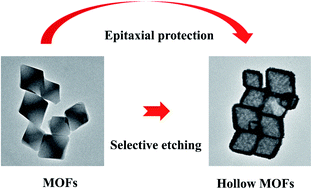Preparation of hollow metal–organic frameworks via epitaxial protection and selective etching†
Abstract
Hollow metal–organic frameworks (MOFs) with only a shell may be used for efficient catalysis. In this work, a general sequential synthesis was employed to successfully create Hf-based hollow MOFs, such as UiO-66, MOF-808, and PCN-223. Etchants including monocarboxylic acids and H2O are required to remove the interior of the MOFs to form hollow structures, while the different stability of the interior and surface of the MOFs partly resulting from surface epitaxy protection was responsible for the selective etching. With these insights, scale-up of hollow octahedral UiO-66 was realized. This work paves a way to rationally design hollow MOFs.

- This article is part of the themed collection: MOFs for energy and environmental applications


 Please wait while we load your content...
Please wait while we load your content...